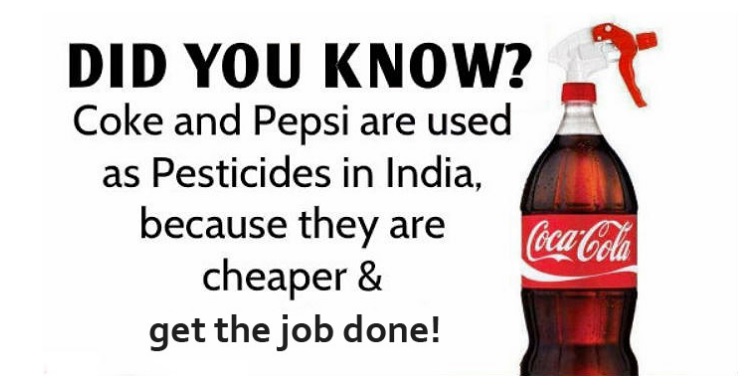You Can Actually Use Coca-Cola And Pepsi As A Pesticide, So Why We Are Still Drinking This Stuff?
Farmers in India have been using Coca-Cola and Pepsi as a cheaper alternative to pesticides. So, besides that they are poisonous for our metabolisms, they also have another function in other parts of the world. Interesting, huh?
CSE (Center for Science and Environment), which is one of the leading voluntary agencies in India said that soft drinks like Coca-Cola and Pepsi contain unacceptably high levels of pesticide residues so numerous farmers used the beverages to eliminate pests because of low costs compared to conventional pesticides.
Coca-Cola has been tested in many cleaning scenarios and it can be compared to brands to clean oil stains, strip paint, and tile grout. The CSE, in 2003 analyzed samples from 12 soft-drink manufacturers and discovered that all of them contain residues of 4 toxic pesticides and insecticides.
The names of them are chlorpyrifos, malathion, DDT, and lindane.

According to the study, the level of chlorpyrifos was 42 times higher than EEC norms, malathion residues were 87 times higher, and lindane (which is banned in the US) was 21 times higher. The concentration of these contaminants in Coca-Cola were 45 times higher and in Pepsi were 37 times higher than the EEC limit.
Moreover, they added that each sample was toxic enough to cause nervous system damage, cancer, damage to the reproductive system, birth defects, and damage to the immune system.
Coca-Cola and Pepsi strongly disagree that they products can be used as pesticides. However, farmers in these parts of the world successfully use them to protect their rice plantations against pests.
On the other site, agricultural specialists claim that farmers mistake that these drinks have the same function as the pesticides. They say that these products are sugar syrups and if they are sprayed on the crops they can attract red ants that feed on the larva of insects.
It is not a Coca-Cola’s legendary secret ingredient that upsets the bugs but the farmers swear by Thumbs Up, Pepsi, and other local soft-drinks. The main ingredients are sugar and water while some manufacturers add phosphoric and citric acids to give an extra taste.
Also, they claim that using the sugar syrup for pests isn’t a new practice as the farmers used sugary solutions, traditionally, to attract red ants to feed in the larva of insects. This is happening because the plants get a direct supply of sugar and carbohydrates that boost the immunity of the plant that ends up yielding better crops.
Moreover, the laboratories of CSE tests samples of popular brands of soft drinks in the US and found that they didn’t contain pesticide residue.
More than 95% of the US soft drinks are made with municipal water supplies that contain the same toxins and pharmaceuticals like trimethoprim, sulfamethoxazole, gemfibrozil, estrone, carbamazepine, atrazine, atenolol, chlorine, arsenic, and fluoride.
The CSE have found that the regulations for the massive soft-drinks industry are weaker as compared to the industries for bottled water. The norms that regulate the cold drinks quality are inadequate, leaving the sector virtually unregulated.
So pampered is a sector of lucrative soft drinks that is exempted from the industrial licensing provisions under the Industries Act, 1951. We all know that the cola is not 100 percent organic or natural but for sure it must be safer that the other traditional poisons.
Read also: This Is What Happens To Your Body One Hour After Drinking A Can Of Coke
Other practical uses of Coca-Cola and Pepsi include:
- It can clean the blood stains from your clothes.
- You can soak pennies in Coke to polish them.
- You can also use it to descale a kettle.
- If you want to clean the toilet, coke is the right thing for you. Just pour it in the toilet bowl, leave it a while, and then flush clean.
- It can eliminate the grease stains from your clothes and fabrics.
- To clean the oil stains in the garage, you should pour some on the floor, and then hose off.
- Due to the high concentration of acids, it can kill slugs and snails.
- Coke can be very helpful when you eliminate the rust stains from your pool. You should pour 2 liters of Coke in the pool, and let it act for few minutes.
- Soak a sponge or a cloth, or even an aluminum foil, in Coke, and you can remove rust and rusty bolts.
- Pour each of the car battery terminals with a bit of Coke to clean them.
- Dip the hair in a bit of Coke and keep it this for 2 minutes, and wipe it off, in order to remove the gum stuck in the hair.
- It’s also useful to clean engines.
- Coke can help you remove pain from your metal furniture. You should dip a towel in it, and apply it on the paint stains.
- Pour a bit of Coke on the kitchen floor, leave it to act, and then wipe it to clean the tile grout.
- Coke can help you fade or remove the hair dye.
- Coke, combined with aluminum foil, can efficiently polish Chrome.
- Use it to clean the stains from vitreous china.
- In order to clean the marker stains on the carpet, pour a bit of it, scrub, and rinse with soapy water.
- Coke can also dissolve a tooth. If you place a tooth in a sealed container filled with Coke and leave it for a longer time, it will dissolve.
- You should pour some Coke in your burnt pans, leave it to act, and rinse the pan to clean it.
Read also: Bye-Bye Sugary Drinks! This Is What Happens To Your Body When You Stop Drinking Soda